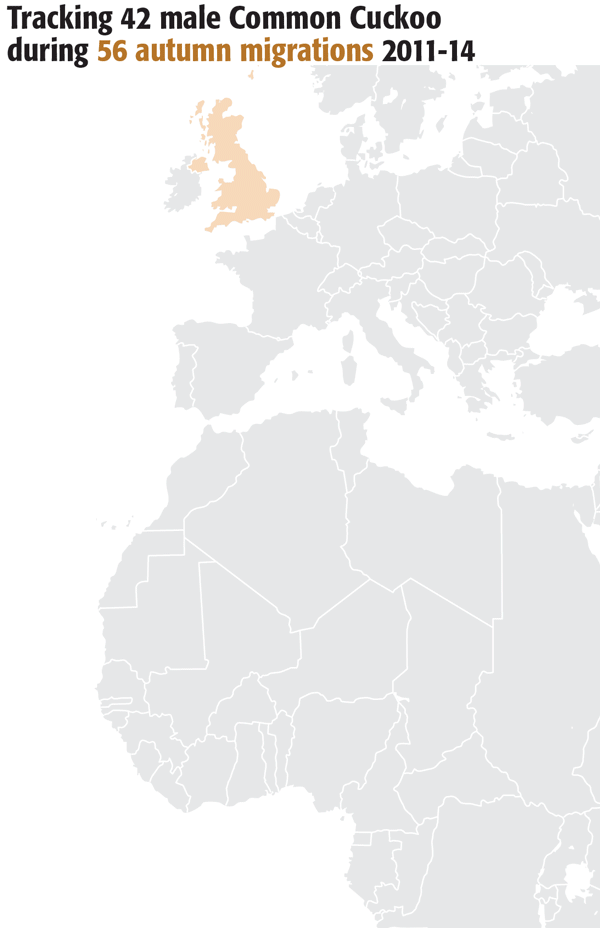Citation

Overview
When the BTO began ground-breaking Cuckoo tracking project in 2011, we had very little idea where these birds spent the winter or how they got there. Our latest research not only reveals this information, but also shows that Cuckoos’ use of autumn migration routes helps explain population declines.
In more detail

Like many migrant birds, the Cuckoo is in long-term decline as a breeding bird in Britain, and has been on the Red List of Birds of Conservation Concern since 2009. The breeding behaviour of the Cuckoo has been very well-studied, but until recently, knowledge of this species’ migratory and wintering behaviour was very limited.
In 2011, a BTO team, led by Chris Hewson, set out to change this, using satellite-tags to track the movements of male Cuckoos breeding in East Anglia. This study has since been extended to track males from several other sites across Britain.
This work has not only revealed details of Cuckoos’ migration timings and wintering grounds, but has also showed “our” breeding birds take one of two routes south to Africa after breeding. Crucially, differential rates of mortality have been found on these routes, which strongly correlate with breeding population trends.
The study included information from 42 male Cuckoos tagged at nine different breeding locations in England, Scotland and Wales, and tracked over 56 autumn migrations between 2011 and 2014. Birds either migrated southwest via Spain and Morocco (the ‘west route’) or southeast via Italy or the Balkans (the ‘east route’) before converging in the Congo basin of central Africa.
Birds taking the west route left eight days later on average than those taking the east route. Interestingly, birds on the west route were more likely to die before completing the Sahara crossing, even though their route was 12% shorter to this point, demonstrating route-specific costs of migration for the first time.
There was no difference in survival during the rest of their southward migrations, or during their return northward journeys to the breeding grounds. The differences in survival were correlated with breeding population changes assessed via two independent datasets – from bird Atlases in 1988-1991 and 2007-2011, and from the annual BTO/JNCC/RSPB Breeding Bird Survey. The strong relationships found provide the first direct evidence that conditions encountered during migration can have an impact on breeding populations.
Despite the obvious ecological barrier presented by the Sahara, most of the mortality on the west route occurred in Europe, suggesting the conditions at stopover sites are responsible. In recent years, Spain has suffered droughts and wildfires, which might have affected the Cuckoos, although other factors like large-scale habitat change might also have played a role.
Declines in Cuckoos’ main food source on the breeding grounds (the caterpillars of large moths) were also particularly severe in areas in which birds migrating on the west route were tagged, which might have compounded difficulties encountered further south, especially given their later departure dates from the UK but similar arrival time south of the Sahara, which suggests they may undertake more fattening here than birds that migrate via Italy. The fact that the western route persists despite the apparent disadvantages suggests that the conditions leading to increased mortality have arisen recently.
This study not only demonstrates how conditions during migration can influence the population dynamics of long-distance migrants through effects on survival, but also underlines the need for a full annual-cycle approach to understanding migratory birds and their conservation needs.
The results show unexpected variation in migration routes and mortality and this illustrates that we need to collect information on the variability in migratory behaviour and performance if we are to understand migratory animal declines in general. Future work of this sort will be vital for the conservation of Afro-Palaearctic migrants. It will be needed to identify key areas where stopover site quality has declined, and could be used to predict future responses of species to climate change, for instance.
Acknowledgements
The BTO Cuckoo Tracking Project was funded by BBC Wildlife Fund, Essex and Suffolk Water, The Sound Approach and BTO ‘Cuckoo Sponsors and Champions’ (including the Broads Authority, Dartmoor National Park, Devon Birds and Sussex Ornithological Society).
We thank Thomas Alerstam, Samantha Franks, Alison Johnston, Raymond Klaassen, Roine Strandberg, Joe Tobias and Mikkel Willemoes for comments on the manuscript, and Samantha Franks and Alison Johnston for assistance with preparation of figures. Simon Gillings provided Atlas data on behalf of BTO and Scottish Ornithologists’ Club and Dario Massimino provided data from the BTO/JNCC/RSPB Breeding Bird Survey.
We thank the volunteers who collected data for both surveys. We thank Malcolm Burgess, John Calladine, Tony Cross, Paul Noakes and Kelvin Jones for assistance in the field with cuckoo tagging and Paul Howey for assistance with PTTs.


